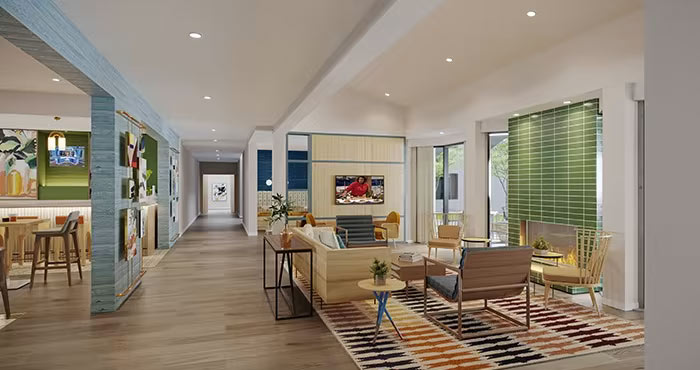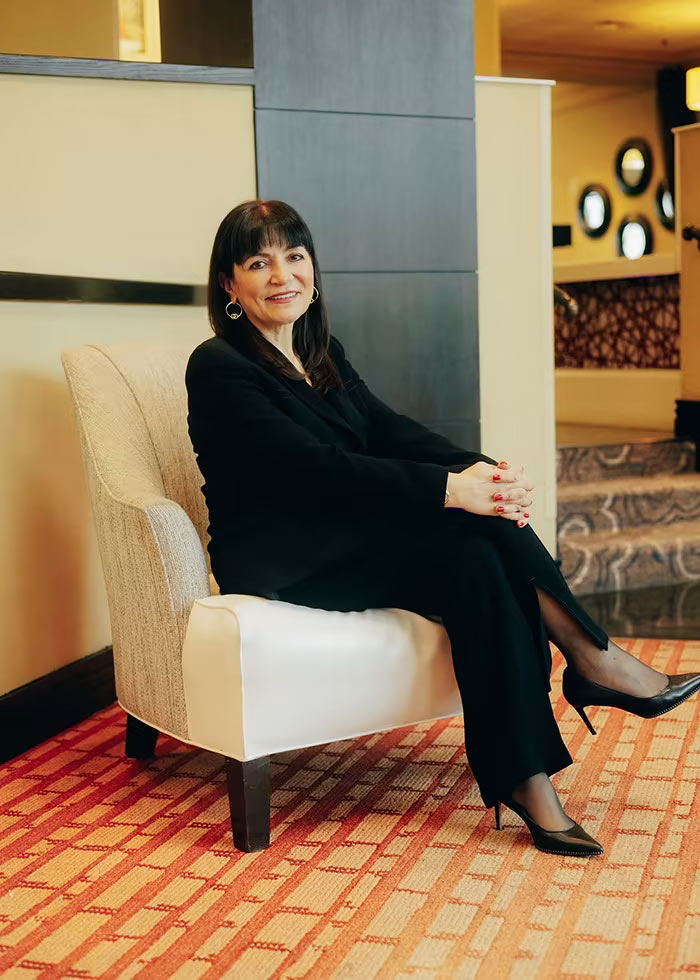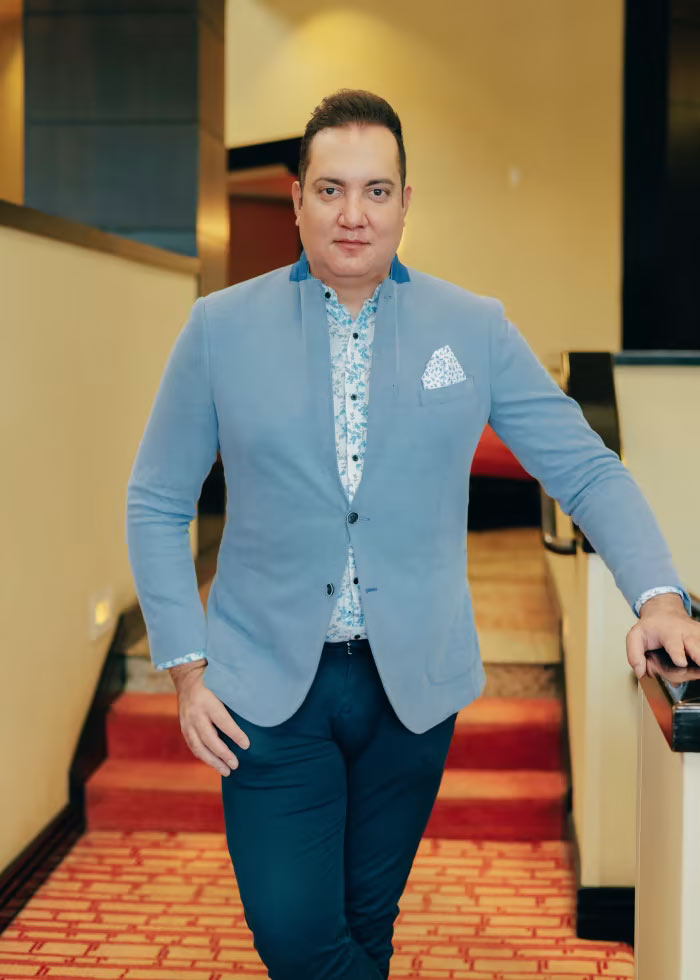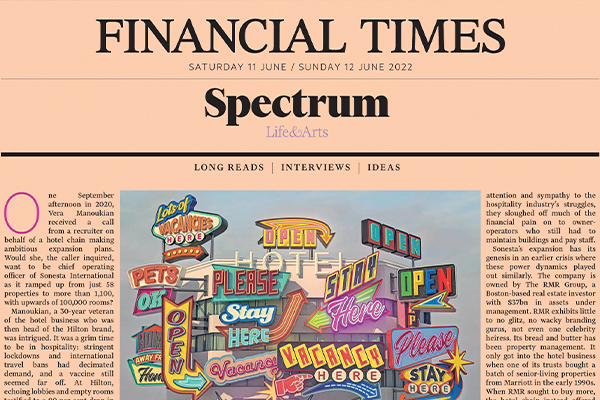One September afternoon in 2020, Vera Manoukian received a call from a recruiter on behalf of a hotel chain making ambitious expansion plans. Would she, the caller inquired, want to be chief operating officer of Sonesta International as it ramped up from just 58 properties to more than 1,100, with upwards of 100,000 rooms?
Manoukian, a 30-year veteran of the hotel business who was then head of the Hilton brand, was intrigued. It was a grim time to be in hospitality: stringent lockdowns and international travel bans had decimated demand, and a vaccine still seemed far off. At Hilton, echoing lobbies and empty rooms testified to a 90 per cent drop in revenue, suspended dividends and mass furloughs.
Manoukian, 58, is a fast walker and a faster talker. Leaving Lebanon for the US as a teenager, she studied chemistry in college and stumbled into hospitality after seeing a “help wanted” sign. She rose rapidly, becoming Sheraton’s youngest hotel general manager at the age of 29. By 2020, she had worked for huge players including Starwood and Hilton, and watched as the industry bounced back from 9/11, the financial crisis, recession and more. But to be planning a post-pandemic expansion in the depths of the pandemic was something else.
There was only one problem: “What is a Sonesta?” she asked.
Founded in 1937, Massachusetts-based Sonesta once owned luxury hotels such as New York’s Plaza and Washington’s Mayflower. When I was in college in the 1980s, the group’s pyramid-shaped Cambridge hotel was a hot place to take visiting parents (and their credit cards) for brunch. But as large hotel chains transformed into managers and marketers of stables of carefully delineated brands ranging from posh to bare bones, Sonesta withered. In 2011, it was acquired by a little-known real estate investor and had, since then, flown so far under the radar that it was practically invisible.
Sonesta, Manoukian realised, was a unique chance to redefine post-pandemic travel on behalf of a very different kind of hotel company. At a time when industry profits were down more than 95 per cent and the biggest US hoteliers were on the defensive, the real estate moguls who owned Sonesta planned to steal a march. It was already becoming clear that domestic travel would recover much faster than far-flung trips, and the spread of remote working had the potential to fundamentally reshape business travel. Here also was a chance to rethink both the business model and the principles of hotel design in ways that would help coax germaphobes back out on the road. Shocking some of her former colleagues, Manoukian became Sonesta’s COO in November 2020. The chance to start from scratch was too unusual to pass up.
World-shaking events aside, the hotel business isn’t what it used to be. Over the past couple of decades, the biggest chains have steadily gobbled up smaller ones, while simultaneously selling off their actual hotel buildings to concentrate almost exclusively on marketing and operations. The biggest, Marriott, has 30 different brands encompassing more than 8,000 hotels. But you can count the number of properties this nearly $60bn company owns on your fingers and toes — most were spun out into another company in 1993, and the rest were sold off. Same story at Hilton and InterContinental Hotels Group; each owns or directly leases less than 1 per cent of its properties. The rest are mostly split between high-profile locations the companies manage for outside investors and a much larger and growing group of hotels that is owned and operated by franchisees, who must comply with brand standards on decor, service and staffing.
That means when you walk into a brand-name hotel today, no matter whether your room costs $50 or $500, chances are it is the hospitality equivalent of a McDonald’s. In the US, just 5 per cent of hotels are owned or directly managed by chains, while 53 per cent are franchises, up from 47 per cent a decade ago, according to hospitality data provider STR. As it did for so many industries, the pandemic laid bare diverging agendas. While the big hotel brands drew public attention and sympathy to the hospitality industry’s struggles, they sloughed off much of the financial pain on to owner-operators who still had to maintain buildings and pay staff.
 A rendering of a room planned for a refurbished Sonesta property
A rendering of a room planned for a refurbished Sonesta property
 ‘Guests really want to come into a space where they can be in the open but also in their own nook,’ says interior designer Staci Patton, who has worked on the reimagining of the Sonesta Select brand
‘Guests really want to come into a space where they can be in the open but also in their own nook,’ says interior designer Staci Patton, who has worked on the reimagining of the Sonesta Select brand
 Colour and fixtures in the lobbies will be used to define visibly different areas for dining, working and sitting
Colour and fixtures in the lobbies will be used to define visibly different areas for dining, working and sitting
Sonesta’s expansion has its genesis in an earlier crisis where these power dynamics played out similarly. The company is owned by The RMR Group, a Boston-based real estate investor with $37bn in assets under management. RMR exhibits little to no glitz, no wacky branding gurus, not even one celebrity heiress. Its bread and butter has been property management. In fact, it only got into the hotel business when one of its trusts bought a batch of senior-living properties from Marriott in the early 1990s. When RMR sought to buy more, the hotel chain instead offered some Courtyard by Marriott and Residence Inn buildings instead. RMR’s portfolio gradually expanded from there, as it struck management deals with other big chains.
RMR’s move into hotels was spearheaded by John Murray, a 61-year-old Long Island native with an accounting degree and earlier stints at EY and Fidelity. As I was reporting this story, he was promoted to become Sonesta’s CEO. Murray is affable and matter of fact when we speak. He tells me it all started with a slap in the face. After the 2008-09 recession, Marriott and IHG dealt with their cash flow problems by refusing to pay RMR more than $100mn of what they owed for use of its buildings until the economy improved. As its experience in the hotel business was limited to real estate, RMR seized their security deposits but then had no other option but to renegotiate the contracts and wait.
When a local hotel brand that had seen better days came up for sale two years later, Murray pounced. “We said, we’re going to buy Sonesta so that if we are ever in that predicament again, the big brands can’t say, ‘We will just stop paying them,’” he says. By the time Covid-19 hit, Sonesta was operating nearly 60 hotels and had successfully launched a new sub-brand, Sonesta ES Suites. In 2020, Marriott and IHG again stopped making some promised payments and said the money might not start flowing until 2025. This time RMR was ready. It cancelled their management contracts and handed over more than 200 hotels to Sonesta. The plan, Murray says, was simple: “We’re going to make Sonesta into a major hotel company.”
“RMR exhibits little to no glitz, no wacky branding gurus, not even one celebrity heiress”
Overnight, signs that read Courtyard, Candlewood Suites and Holiday Inn Crowne Plaza came down, replaced by newly invented brand names and signage. The hotel buildings themselves and on-the-ground staff remained the same. At a former Kimpton in Washington DC, the removal of that brand’s colourful prints left guestrooms feeling generic and half-empty. Some 250 miles north at a former Crowne Plaza in the New York suburbs, the general manager Monika Henry and about 100 workers were grateful they still had jobs. But “we sort of wondered what a Sonesta was”, she says. “We didn’t know who we were.”
Customers were equally confused. Gil Marsden, a documentary-film director, found himself and his crew booked into three Sonestas over a short period of time. One was a bare-bones, extended-stay hotel, while the other two were full-service properties with snazzy ballrooms and room service. The only thing they seemed to have in common was a name he hadn’t heard of. “They don’t feel like they are big enough to have different brands,” says Marsden. “It’s a crapshoot.”
Murray and RMR agreed. So they shelled out $90mn for the parent company of Red Lion Hotels in March 2021. That not only added more than 900 franchised hotels, mostly midscale and economy properties in the west and midwest, but also gave Sonesta the expertise to sign other hotel owners to its chain. “They’ve become a real player in the market,” says Alam Pirani, executive managing director of Colliers Hotels, which advises hospitality investors. “I think they are going to be aggressive.” Manoukian, Sonesta’s new COO, charged in, hiring a former colleague from Starwood as marketing director and someone below her to focus on branding. They brought in consultants to develop slogans and standards and to sketch out new room and lobby designs. Her goal, she says, was: “I want to go from ‘What is a Sonesta?’ to ‘I want a Sonesta.’”
In large markets like the US, a hotel’s brand is crucial because travellers have many options and relatively few sources of reliable advice beyond online booking sites. Guidebooks and listicles about Paris are a dime a dozen; the same is less true for Cincinnati, Ohio or Richmond, Virginia. A branded hotel may be sterile, but it’s a safe bet. “For most people, this is the pinnacle of discretionary spend. They want to lessen the chances of disappointment,” says Robin Hutson, co-founder of the UK’s Hotel du Vin and The Pig, both of which managed to combine the recognisability of a chain with boutique sensibility.
In theory it shouldn’t be that hard to get hotel branding right, Hutson says. “Basics will go a long way. The minimum you want from a hotel is a really great mattress, enough water pressure in the shower, and you want it to be dark and quiet and the pillow to be soft. It is not rocket science.”
 Sonesta International chief operating officer Vera Manoukian at the company’s White Plains hotel © Timothy O’Connell
Sonesta International chief operating officer Vera Manoukian at the company’s White Plains hotel © Timothy O’Connell
Yet when Sonesta executives started running focus groups with guests and potential guests, they discovered that many of them found travel inherently stressful, a feeling only exacerbated by the pandemic. Booking a hotel was particularly nerve-racking because so many places failed to live up to photos posted online. To the new chief marketing and brand officer Elizabeth Harlow, who started in hospitality as a front-desk clerk in The Mayflower, that unease seemed like an opportunity. “Guests were hungry for a sense of calm and things to help them offset anxiety. So how do we create spaces or experiences that fulfil those needs?”
At Sonesta’s budget, extended-stay properties, the answer was pretty straightforward. Guests there are often workers — in construction, say, or nursing — on extended assignments that might last for months at a time. These conditions mean small irritations can eventually loom large. The hotels offer few amenities to boast about, but the staff quickly become familiar faces. So the branding team boiled down the proposition for the range of properties, called Simply Suites, to offering rooms that have “everything you need and nothing you don’t”. That means free laundry facilities, kitchens, WiFi and a fitness centre as standard, though no spas or restaurants. “Everyone relies on our guests, so they can rely on us,” Harlow says. “We are not going to tell you it’s one thing, and when you get there it is something else.”
Finding an identity for the group’s full- service Sonesta Hotels and Resorts was a lot harder. The properties are a motley collection of urban boutiques, standard business hotels and beach resorts. Sonesta turned to Catch, a New York-based branding agency, to come up with ideas. Digging through the focus groups, they found that almost everyone, even business travellers, was seeking a way to take the edge off. “We heard the word ‘relax’ across all of the traveller categories a shocking amount of time,” says Douglas Spitzer, Catch’s co-founder. “We never really heard that outside of a vacation in the past.”
As a result, Sonesta’s full-service hotels adopted a slogan — “Check out the moment you check in” — and are gearing their services around “discovery”. How well this works is arguably the biggest test of Sonesta’s marketing plans. While domestic leisure travel has rebounded, business travel remains profoundly depressed. The Global Business Travel Association predicts that total corporate travel spending, which plunged 53 per cent in the first year of the pandemic, will climb back to $1tn in 2022 but won’t recover to 2019 levels until at least 2024. And room usage has shifted. While business hotels used to be full from Monday to Thursday, travellers are now focused on what the industry calls “bleisure”, a combination of business travel or remote work around a personal weekend. So Thursday to Monday are now busy days, and travellers want a lot more information about the hotel’s surroundings.
The same trends are also prompting larger hoteliers to rethink their offerings. Accor, which has 5,300 hotels and 40 brands, has long been stronger among business customers. But it recently launched a string of all-inclusive resorts in Turkey and Egypt because “people want to have meeting spaces, entertainment and water sports in the same venue”, says Patrick Mendes, Accor’s chief commercial officer. “They want to be able to work and go with their family at the same time.”
On a snowy February day, Manoukian strides to the front of a big ballroom in White Plains, New York to the sound of INXS. “Need You Tonight” is blaring, and the assembled hotel staff are cheering loudly. “Let’s bring down the house, guys,” she says, grabbing a Sonesta-branded clapper and shaking it. “I love your energy and passion. I’m going to bottle it.”
Her visit is the culmination of a week-long training session meant to get Sonesta employees around the country enthused about their new brand and about growing the company. Reception agents, housekeepers and maintenance workers alike have been deluged with Sonesta swag, offered meals usually reserved for guests and invited to discuss how the company’s various slogans would apply to their jobs and their hotel’s target guests.
“The designs incorporated the latest research on germaphobic travellers, such as keeping corners visible and using light-coloured bathroom surfaces.”
Anyone who has sat in on a similar session knows marketing speak can quickly get abstruse. But when talk of a “powerhouse” customer-type — a demanding business traveller who might tack on some leisure time — comes up, some of the White Plains staff immediately perk up. They have a specific customer who always wants Room 1202 and makes her displeasure clear if it is not available. “So now it’s in her profile. For the powerhouse, we provide solutions, not excuses,” says Tonya Inman, the local sales director. “Now that Sonesta has outlined what each brand represents, it makes it a lot easier how we sell to each target customer.”
As the staff raise plastic flutes of sparkling cider to toast the changes, Manoukian sums up the task at hand: “You are the ones who are going to bring the brand to life.”
But rallying the troops will not be enough. “Hotels should offer a bit of fantasy that you don’t get when you walk through the front door of your own house. There is something exciting about that little thing that is ‘free’ that you aren’t expecting,” Hutson says. Perhaps the most famous effort along these lines started in the 1980s at DoubleTree, now owned by Hilton. The chain first put freshly baked chocolate-chip cookies in VIP rooms as part of nightly turndown services, but it eventually shifted to handing them out to everyone at the check-in desk. The chain’s 600-odd hotels now give out 65,000 every day, or more than 25mn a year. “In our focus groups, you would not imagine how many people referred to that cookie,” Harlow says. “It’s such a simple gesture, but people remember it.”
Sonesta’s search for similar gestures is being shaped by the pandemic. For the full-service Sonesta hotels, management aimed squarely at post-Covid travellers. Surveys show that 60 per cent of customers are looking to meet new people on vacation and 79 per cent see travel as part of “self-care”. So those hotels will roll out bar carts stocked with ready-to-drink cocktails in their lobbies. The chain also plans to offer organised group hikes, walks and runs in areas where appropriate, and is negotiating a partnership that will allow guests to download the mindfulness and sleep app Aura for free. “There’s a fundamental rethinking of travel and how important it is to our sense of wellbeing,” says Max Buccini, Sonesta’s new brand leader.
 Sonesta chief marketing and brand officer Elizabeth Harlow: ‘Rather than having things that might be perceived as radically different, we wanted to develop things that our guests were asking for’ © Timothy O’Connell
Sonesta chief marketing and brand officer Elizabeth Harlow: ‘Rather than having things that might be perceived as radically different, we wanted to develop things that our guests were asking for’ © Timothy O’Connell
 ‘There’s a fundamental rethinking of travel,’ says Max Buccini, Sonesta’s global brand leader, ‘and how important it is to our sense of wellbeing’ © Timothy O’Connell
‘There’s a fundamental rethinking of travel,’ says Max Buccini, Sonesta’s global brand leader, ‘and how important it is to our sense of wellbeing’ © Timothy O’Connell
The more budget Simply Suites is focusing on helping to counteract the loneliness that long-term guests may experience. This includes offering free, freshly popped popcorn in the lobby at 6pm daily, twice-monthly visits from local food trucks and a grill on the patio to encourage guests to congregate. “The hotels are simple but not basic,” Harlow says. “There’s no pool, no spa. [But] every property will have a grill. It’s like coming home from work every day. You can gather around the barbecue and have a beer.”
What is certain to matter day to day are the hundreds, even thousands of standards that will come to define Sonesta’s brands. These range from the operational (the size of pillows and how long they can be used before being discarded) and the experiential (the genre of music playing in the lobby and its volume) to design (the colour of the carpets in the corridors). As “asset light” hoteliers, Hilton, IHG and the other big chains use such standards to ensure guests receive a uniform experience. But expansive requirements — particularly for physical standards, known as ADC (architecture, design and construction) — can and do lead to resentment among building owners and franchisees who have to foot the bills.
Murray and his colleagues think they can turn their real estate pedigree to their advantage as Sonesta grows. They aim to woo other owners to convert their existing hotels to Sonestas through a new franchising arm, unveiled last September. “The large brands have no skin in the game. They don’t own hotels. When they say, ‘You have to rip out your tubs and put in showers, or you have to have 24-hour room service, even if you have an empty hotel’, franchisees don’t like rules that don’t make sense,” Murray says. “When we come up with brand standards . . . we have to live with them. We’re putting our money where our mouth is.”
Staci Patton, a Chicago-based interior designer at DLR Group who specialises in hotels, can certify that is true. Hired last autumn to reimagine the Sonesta Select brand as a mid-price boutique, she was handed pages and pages of specifications about the 60-odd existing hotels, along with warnings about what could and could not be changed, from the finishes in the bathrooms to the location of the hotel’s restaurant. Her original idea of putting local elements in each hotel was scrapped in favour of a more generic, and less expensive, theme: “Neighbourhood hotels made personal.” Lighting aimed at making the hotels’ outdoor space more welcoming was toned down from fancy lanterns to string lights. The designs also incorporated the latest research on germaphobic travellers: wood floors and lacquered furniture rather than fluffy carpets and soft surfaces. Keeping corners visible and using light-coloured bathroom surfaces help reassure guests that rooms really are clean.
In the lobby, the hotels will use colour and fixtures to create visibly different areas for dining, working and sitting, so they feel less cavernous when only partly full — a familiar problem during the pandemic. That means a blue stained-wood area between reception and the restaurant, and a bright yellow booth for making private phone calls. “Guests really want to come into a space where they can be in the open but also in their own nook,” Patton explains. “Together, but alone-together.”
Sonesta’s rethink of post-pandemic travel looks a lot more like a series of tweaks than a wholesale shake-up. And compared to some of the edgier offerings at the bigger chains, the branding is relatively vanilla. That’s on purpose. Harlow, Sonesta’s marketing chief, argues the chain is putting owners and guests first. “This is what they’re looking for in their physical spaces. This is what they need,” she says. “Rather than having things that might be perceived as radically different, we wanted to develop things that our guests were asking for. Crazy standards are one thing, but unless we deliver the best guest experience we can, based on what our guests are telling us, they don’t mean a whole heck of a lot.”
To that end, Sonesta recently revamped its website and launched its first smartphone app, making it easier to book. A relaunched loyalty programme is due in the autumn. In the meantime, it has signed up 20 franchise hotels and expects to hit 50 by June, crucial to getting its name in front of more people. It re-entered the New York City market in April by purchasing a majority stake in four Manhattan boutique hotels. “If you don’t have a hotel in New York, you don’t really have a brand,” says Murray. This isn’t hubris: meeting planners and big corporate travel departments won’t do business with a chain that doesn’t have several New York options. He is looking for deals in Miami and Los Angeles, two huge markets where Sonesta lacks a presence.
Sonesta remains 50 years and many billions behind the big names in corporate hospitality. Marriott, Hilton and IHG each have more than 5,000 hotels and dozens of brands among them. Not that it seems like much of a deterrent to Murray. In early April, the company convened its new customer advisory board, composed of guests and business partners, in San Juan, Puerto Rico. Murray showed up to make a personal pitch on the chain’s behalf. “Our goal is that when somebody says, ‘Where are you going to stay?’, they’ll answer, ‘I’m debating’, [and] we want to be in that conversation.” He was delivering his speech to a meeting room in a recently refurbished, luxury Sonesta.
SOURCE: https://www.ft.com/content/7369f018-07ef-46b7-bca7-5087f80158ed

